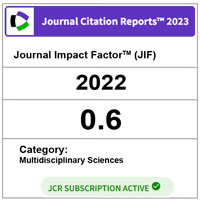Effect of particle size and amount of nonmetallic PCB materials on the mechanical properties of rHDPE/PCB composites
DOI:
https://doi.org/10.11113/mjfas.v15n2.1089Keywords:
Nonmetallic printed circuit board, particle size, mechanical properties, chemical compositions, morphologyAbstract
Composites based on recycled high density polyethylene (rHDPE) and nonmetallic printed circuit board (PCB) waste were made through melt compounding and compression molding. In this study, the chemical compositions of the nonmetallic PCB material were determined via XRF and it was confirmed that it contains predominantly 72.7% of glass fiber materials which improve the mechanical performances of the rHDPE matrix. The main aim of this study is to determine the effect of different particle sizes and loadings of nonmetallic PCB on mechanical properties of rHDPE/PCB composite. The results indicated that mechanical properties of composites were excellent when nonmetallic materials with particle size from 0.09 to 0.15 mm and adding amount was 30 wt%. Microscopic images revealed that nonmetallic particles with the size of 0.07-0.09 mm and 0.09 -0.15 mm contained majority of single glass fibers whereas, bigger particle sizes of 0.15-0.3 mm and 0.3-0.5 mm, contained glass fibers in the form of bundles and large resin sheet.
References
Brigden, K., Labunska, I., Santillo, D., Allsopp, M. 2005. Recycling of electronic wastes in China and India: Workplace and environmental contamination. Greenpeace Research Laboratories, Technical Note 09/2005, August 2005.
Dalrymple, I., Wright, N., Kellner, R., Bains, N., Geraghty, K., Goosey, M., et al. 2007. An integrated approach to electronic waste (WEEE) recycling. Circuit World, 33, 2, 52-58.
DOE. 2009. Percentage of scheduled waste generated by category. Retrieved from Department of Environment website: http://www.doe.gov.my/portal
DOE. 2012. List of contractor. Retrieved from Department of Environment website: http://www.doe.gov.my/ portal
Goosey, M., Kellner, R. 2003. Recycling technologies for the treatment of end of life printed circuit boards (PCBS). Circuit World, 29, 3, 33-37.
Guo, J., Rao, Q., Xu, Z. 2008. Application of glass-nonmetals of waste printed circuit boards to produce phenolic moulding compound. Journal of Hazardous Materials, 153, 1, 728-734.
Hall, W. J., Williams, P. T. 2007. Separation and recovery of materials from scrap printed circuit boards. Resources, Conservation and Recycling, 51, 3, 691-709.
He, W., Li, G., Ma, X., Wang, H., Huang, J., Xu, M., et al. 2006. WEEE recovery strategies and the WEEE treatment status in China. Journal of Hazardous Materials, 136, 3, 502-512.
Hino, T., Agawa, R., Moriya, Y., Nishida, M., Tsugita, Y., Araki, T. 2009. Techniques to separate metal from waste printed circuit boards from discarded personal computers. Journal of Material Cycles and Waste
Management, 11, 1, 42-54.
LaDou, J. 2006. Printed circuit board industry. International Journal of Hygiene and Environmental Health, 209, 3, 211-219.
Li, J., Lu, H., Guo, J., Xu, Z., Zhou, Y. 2007. Recycle technology for recovering resources and products from waste printed circuit boards. Environmental Science & Technology, 41, 6, 1995-2000.
Martin, W. J. 1997. Printed circuit board materials handbook. Chatsworth California: McGraw-Hill.
Muniyandi, S. K., Sohaili, J., Hassan, A. 2013. Mechanical, thermal, morphological and leaching properties of nonmetallic printed circuit board waste in recycled HDPE composites. Journal of Cleaner Production, 57, 327-334.
Muniyandi, S. K., Sohaili, J., Hassan, A. 2016. Accelerated weathering properties of compatibilized composites made from recycled HDPE and nonmetallic printed circuit board waste. Journal of Applied Polymer Science, 133, 11.
Norazlina, A. H. 2010. E-waste management in Malaysia. Country presentation: Department of Environment Malaysia.
Perrin, D., Clerc, L., Leroy, E., Lopez-Cuesta, J.-M., Bergeret, A. 2008. Optimizing a recycling process of SMC composite waste. Waste Management, 28, 3, 541-548.
Rabitah, H. Yea. 2000. Portland cement-based solidification/stabilization for the treatment of industrial waste. (Master Thesis), Universiti Teknologi Malaysia, Malaysia.
Rajesh, J. 2008. E-waste: Implications, regulations and management in India and current global best practices. TERI, New Delhi, 4.
Rashid, Z. A., Alias, A. B., Som, A. M., Aris, M. J., Mahmud, E. 2010. Development of generic decision support system for scheduled waste management in Malaysia.
Scarlett, J. A. 1984. An introduction to printed circuit board technology: State Mutual Book & Periodical Service.
Sohaili, J., Muniyandi, S. K., Mohamad, S. S. 2012. A review on printed circuit boards waste recycling technologies and reuse of recovered nonmetallic materials. International Journal of Scientific & Engineering Research, 3, 2, 138-144.
Stevens, G. C., Goosey, M. 2008. Materials used in manufacturing electrical and electronic products. In Electronic Waste Management (pp. 40-74).
Theng, L. C. 2008. E-waste management. Impact Issues, 1, 12-13. Torretta, V., Ragazzi, M., Istrate, I. A., Rada, E. C. 2013. Management of waste electrical and electronic equipment in two EU countries: A comparison. Waste Management, 33, 1, 117-122.
UNEP. 2007. E-waste Volume 1: Inventory assessment manual. Retrieved from United Nations Environment Programme website: http://wedocs.unep.org/handle/20.500.11822/7857
Veit, H. M., Diehl, T. R., Salami, A. P., Rodrigues, J. d. S., Bernardes, A. M., Tenório, J. A. S. 2005. Utilization of magnetic and electrostatic separation in the recycling of printed circuit boards scrap. Waste Management, 25, 1, 67-74.
Zheng, Y., Shen, Z., Cai, C., Ma, S., Xing, Y. 2009. Influence of nonmetals recycled from waste printed circuit boards on flexural properties and fracture behavior of polypropylene composites. Materials & Design, 30, 4, 958-963.







